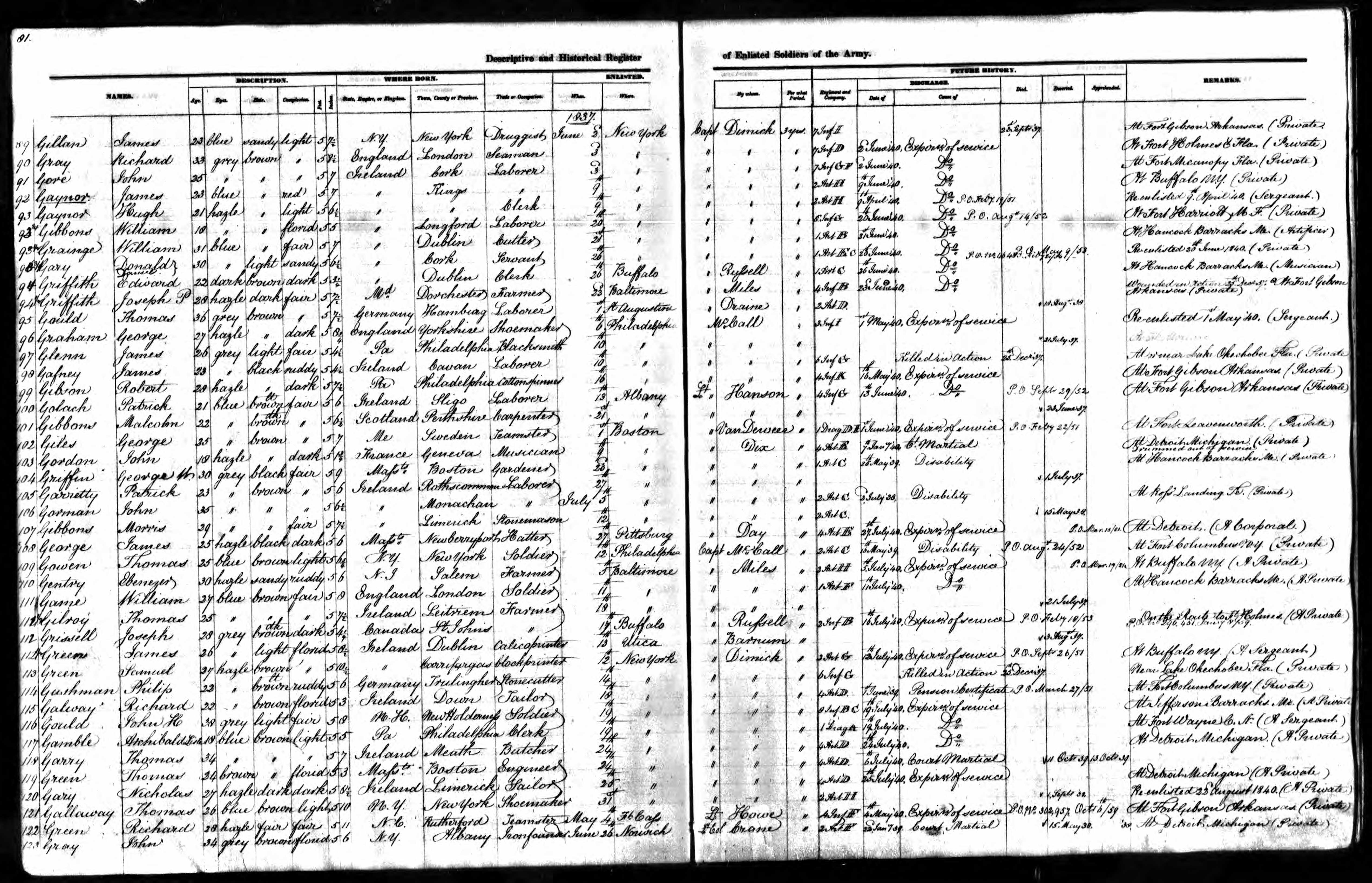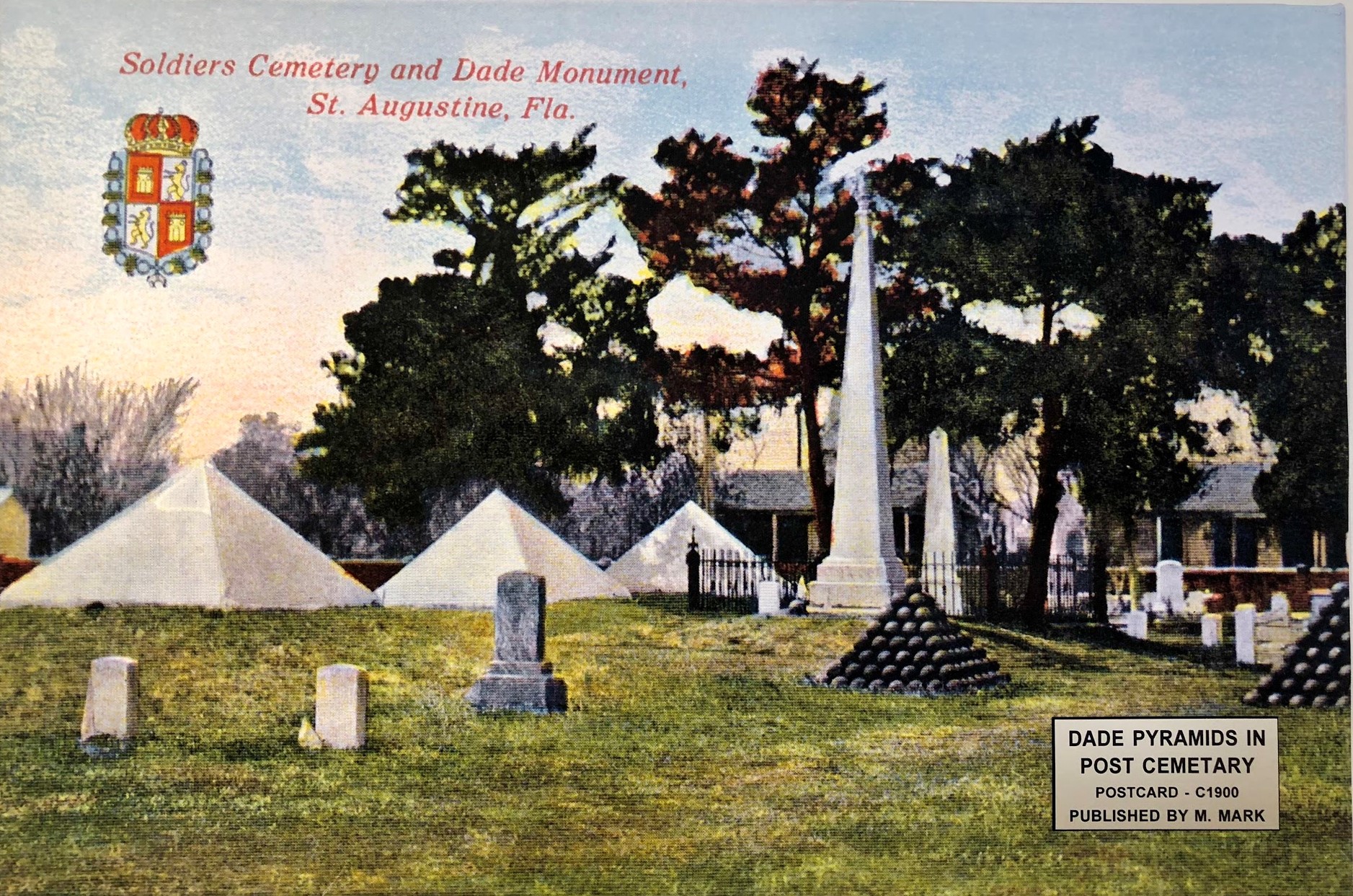James Gaffney (1814–1837)
By Elizabeth Klements
Early Life
James Gaffney was born in Navan, Ireland, in 1814.1 He immigrated to the United States sometime prior to 1837.2 Between the 1820s and 1860s, Irish immigrants made up one third of immigrants into the United States.3 Immigrants from Ireland faced discrimination and racism upon arrival, and competition for jobs was fierce.4 Gaffney worked as a laborer before he enlisted in the US Army out of Philadelphia, Pennsylvania, at the age of twenty-three, as shown here.5 He enlisted in June 1837, during a period of wide-spread financial hardship.6 Former President Andrew Jackson’s financial policies had led to a severe economic depression beginning in the Spring of 1837; banks collapsed, businesses went bankrupt, and thousands lost their savings. It is possible that by June of 1837 Gaffney could not find work as a laborer and sought employment elsewhere.
Military Service
The Army that Private Gaffney belonged to was very different than the twenty-first century US Army. It was much smaller with about 7,200 soldiers in its ranks organized into twelve regiments composed of four artillery, seven infantry, and one dragoon or cavalry regiments. Approximately 6,600 of these soldiers were enlisted men and about 600 were officers. This small army was scattered in fifty-three separate installations around the nation. Just before the Seminole War, 500 soldiers garrisoned ten bases across northern and central Florida. Many of these men were immigrants because soldiers, wherever they served, were poorly paid; they received five dollars a month. A civilian laborer made much more. As a result, recently arrived immigrants who needed work filled the ranks.7 Private Gaffney was one of these immigrants. As a result of the Second Seminole War, the regular Army almost doubled in size. Despite this expansion, 30,000 militia (part-time soldiers) and volunteer (newly-recruited) units reinforced the regular Army units in their campaigns in Florida against the Seminoles.8
Private Gaffney was part of G company in the 6th Infantry Regiment.9 Congress officially created the 6th Infantry Regiment in 1808. The 6th Infantry first participated in the War of 1812 and then moved along the western US frontier, where soldiers constructed forts and engaged in skirmishes with Native Americans, most notably in the Black Hawk War of 1832. The US Government ordered the 6th Infantry to proceed to Florida in 1836, amidst rising tensions between the US and Seminoles.10
Fought between 1835 and 1842, the Second Seminole War was part of a larger conflict between Native Americans in Florida and the United States military that lasted from 1816 to 1858. In alignment with the goals of the Indian Removal Act (1830), the United States government sought to move all of the Florida Native Americans, collectively—though inaccurately—referred to as Seminoles, from the peninsula to the Indian Territory (modern-day Oklahoma). Fighting in a harsh environment, against a mobile foe using guerrilla tactics, and without clear frontlines, the army struggled to defeat their outnumbered enemy. While estimates vary, approximately 10,000 soldiers and as many as 30,000 militia fought against fewer than 2,000 Seminole warriors. Eventually, after seven years, the death of 1,400-1,500 regular US Army soldiers, and the expenditure of $30,000,000-$40,000,000, the United States declared victory even while some Seminoles remained in Florida. Given these hardships, the Second Seminole War is generally considered “the longest and most costly of the Indian conflicts.”11
Surpassed only by Dade’s Battle in terms of casualties, the Battle of Okeechobee occurred on December 25, 1837, two years after the war began. On Christmas Day, commanding officer Colonel Zachary Taylor led approximately 800 infantry regiment troops into battle against 380-480 Seminoles who were camped on the shore of Lake Okeechobee. The 6th and the 4th Infantry regiments led the attack at the Battle of Okeechobee, but the 6th Infantry bore the brunt of the Seminole’s fire.12 They lost four officers and sixteen privates, including Private Gaffney – far more than any other regiment in the engagement.13 Though Taylor claimed this battle as a great victory, the Seminoles – who had positioned themselves in a densely wooded area with a half mile of swamp in front of them – inflicted more extensive damage to the US troops than they themselves received. After three hours of battle, the Seminoles retreated in canoes across the lake, having lost less than seven percent of their men while Col. Taylor lost over seventeen percent of his forces. Further, the Seminoles successfully slowed Taylor’s march down the Kissimmee River long enough to evacuate their women and children farther into the Everglades. Public opinion regarding the battle’s outcome was initially mixed, but the nation eventually accepted Taylor’s claim of victory, propelling him into the national spotlight and initiating his road to the presidency.14
Legacy
Along with some 1,500 US casualties of the Second Seminole War, James Gaffney is memorialized at St. Augustine National Cemetery in Florida. On June 13, 1842, as a prelude to the formal ending of the Second Seminole War, Col. William Worth announced that the remains of the officers who fell in the war would be gathered and reinterred in the burial ground next to the St. Francis Barracks in St. Augustine. The bodies of Maj. Francis Dade and his men were interred along with other regular soldiers in three massive vaults, each covered by an ornamental pyramid constructed of native coquina stone, as seen here. Two years later, a granite obelisk was erected next to the pyramids. The US Government re-designated the St. Francis Barracks burial ground as St. Augustine National Cemetery in 1881. The so-called “Dade Pyramids” and memorial obelisk are believed to be among the oldest public monuments (excluding headstones) in the national cemetery system.15
Endnotes
1 The “Register of Enlistments” spells his last name “Gafney” but the “Returns of the Killed and Wounded” use the more common spelling, “Gaffney,” which will be used here; “U.S. Army, Register of Enlistments, 1798-1914,” database, Ancestry.com, (http://www.ancestry.com/ : accessed January 16, 2020) entry for James Gafney; “Returns of the Killed and Wounded in Battles, 1790-1844,” database, Ancestry.com, (http://www.ancestry.com/ : accessed January 16, 2020) entry for James Gaffney.
2 “U.S. Army, Register of Enlistments, 1798-1914,” database, Ancestry.com, (http://www.ancestry.com/ : accessed January 16, 2020) entry for James Gafney.
3 “Irish-Catholic Immigration to America”, Library of Congress (http://www.loc.gov/teachers/classroommaterials/presentationsandactivities/presentations/immigration/irish2.html: accessed January 10, 2020).
4 “Joining the Workforce,” Library of Congress (http://www.loc.gov/teachers/classroommaterials/presentationsandactivities/presentations/immigration/irish4.html: accessed January 10, 2020).
5 “U.S. Army, Register of Enlistments, 1798-1914,” database, Ancestry.com, (http://www.ancestry.com/: accessed January 16, 2020) entry for James Gafney.
6 “U.S. Army, Register of Enlistments, 1798-1914,” database, Ancestry.com, (http://www.ancestry.com/: accessed January 16, 2020) entry for James Gafney.
7 Captain Michael G. Anderson, Staff Ride Handbook for Dade’s Battle, Florida, 28 December 1835: A Study of Leadership in Irregular Conflict (Leavenworth KS: Combat Studies Institute Press: US Army Combined Arms Center), accessed January 10, 2020, https://www.armyupress.army.mil/Portals/7/educational-services/staff-rides/StaffRideHB_DadesBattle.pdf.
8 U.S. Army, “Toward a Professional Army,” in The United States and the Forging of a Nation, 1775-1917, edited by Richard W. Stewart (Washington DC: Center for Military History, 2005), accessed January 10, 2020, https://history.army.mil/books/AMH-V1/ch07.htm.
9 “U.S. Army, Register of Enlistments, Ancestry.com, Charles Hottick.
10 Charles Byrne, “The Sixth Regiment of Infantry,” U.S. Army Center of Military History, accessed January 16, 2020, https://history.army.mil/books/R&H/R&H-6IN.htm.
11 C.S. Monaco, The Second Seminole War and the Limits of American Aggression (Baltimore: Johns Hopkins University Press, 2018); John and Mary Lou Missall, The Seminole Wars: America's Longest Indian Conflict (Gainesville, FL: University Press of Florida, 2004); John K. Mahon, History of the Second Seminole War (Gainesville, FL: University of Florida Press, 1967); Quote from Jane F. Lancaster, Removal Aftershock: The Seminoles' Struggles to Survive in the West, 1836–1866 (Knoxville, TN: The University of Tennessee Press, 1994), 18.
12 Mahon, History of the Second Seminole War, 228.
13 Byrne, “The Sixth Regiment of Infantry,” U.S. Army Center of Military History.
14 Mahon, History of the Second Seminole War, 219; “Colonel Z. Taylor’s Account of the Battle with the Seminole Indians,”; John and Mary Lou Missal, eds., This Miserable Pride of a Soldier (Tampa: University of Tampa Press, 2005), 129.
15 John T. Sprague, The Origin, Progress, and Conclusion of the Florida War (New York: D. Appleton & Co., 1848), 521-522; “Saint Augustine National Cemetery,” <i>U.S. Department of Veterans Affairs, accessed January 15, 2020, https://www.cem.va.gov/cems/nchp/staugustine.asp.
© 2019, University of Central Florida




